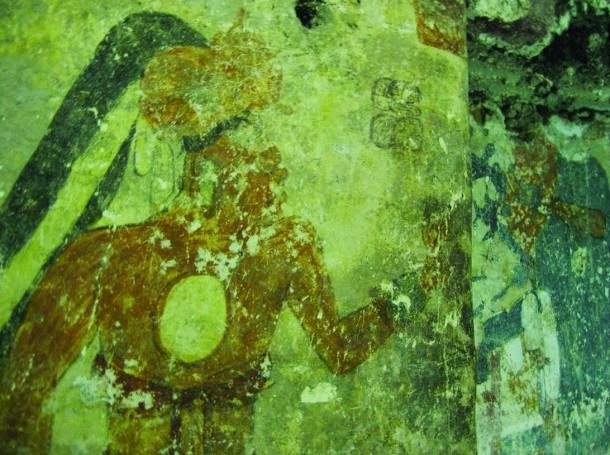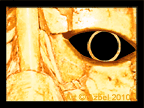In a complex, 1,300-year-old Maya mural in the Guatemalan jungle, a
ruler with an elaborate plumed headdress and impersonating a god,
consults with priest-scholars as they celebrate the new year. Though the
Lord of Hammer-Stone Hill is present, it is a rare glimpse of life that
is not a court scene, say the archaeologists studying it and other
murals in the ancient ruins of the city of Xultun.
The archaeologists are studying not just royalty and the court, but the people of lower status too.
“Our ongoing work seeks to refine understandings of the mechanisms through which sacred royal power was legitimated and maintained, and to elucidate the roles that specialists such as the taaj [functionaries] played in those processes,” wrote the authors of an article about the murals published in the journal Antiquity. “The Xultun mural sheds a rare light on some of these strands as they pertain to a group of seven artisans, scribes and priests; we see here, ‘set before their king’, individuals who played distinct and important roles in producing and sustaining political authority at Xultun.”
The taaj are people (one of them is depicted on the left in the photo of the mural at the top of this article) who served the ruler. Taaj means obsidian. The archaeologists are unsure why the men are called obsidian.
Xultun was discovered in 1915 and studied in the 1920s and again in
1974 and 1975. Unfortunately, some of its artifacts, including large
steles, were looted.
The website Trafficking Culture says the site has plazas, buildings and ball courts. The largest Xultun structure has a nearly square base that measures about 148 feet (45 meters) and is 79 feet (24 meters) tall. On top is a platform with a small structure.
It seems the people of Xultun had a penchant for using minerals as
proper nouns. An “epigraphic study of an emblem glyph associated with
the site indicates that during the Classic Maya period Xultun was called
B’aax Witz or Quartz Hill/Mountain,” Trafficking Culture says.
“Like nearly every Maya site in the Petén, Xultun was heavily looted in the 1960s and 1970s to feed the international demand for Maya ceramics and sculptural material,” the site says.
The authors of the February 2015 article in Antiquity, including lead researcher William Saturno of Boston University, started excavations at Xultun in 2008. The article gives many details on the murals and what significance they may have had to the people of the time.
Also depicted are two men dressed as military captains, though damage makes their identities unclear. The sharing of roles by junior and senior taaj men suggests “a religious order linked to sacrificial rites and thus obsidian blades (ubiquitous in Maya sacrificial rites), or an early guild of master craftsmen and apprentices (journeymen), who may be blood relations.” Also, they wrote, the mural suggests a guild that united trades including artists, calendrical priests and scribes.
There are many texts inscribed on the wall, dealing with astronomical, calendrical and “textual” content, they wrote.
The walls are constructed of stone blocks and wet mortar. Workers prepared the surface with a layer of mud to smooth the surface and then lime plaster.
Several scientific testing methods identified iron-oxide pigments, including hematite, Maya blue, carbon black and calcite white to make dark brown, red, orange, yellow, white, blue, blue-green and purple (red-blue) and yellow.
“On the north wall, the seated lord is distinguished by his
blue-green feathers and jewelry, white shells and skeletal ornaments, as
well as by calligraphic outlines in both black and red specular
hematite. The materials and techniques used to paint the Xultun chamber
are consistent with artworks by other master artists and scribes
painting murals and pottery.”
The authors intend to write later articles detailing the results of excavations of the murals and analysis of hieroglyphic texts that are on the paintings.
Featured image: Junior Obsidian kneels before the Lord of Hammer-Stone Hill, the apparent ruler of Xultun.
Source: http://www.ancient-origins.net
(Illustrations from Antiquity journal)
By Mark Miller
The archaeologists are studying not just royalty and the court, but the people of lower status too.
“Our ongoing work seeks to refine understandings of the mechanisms through which sacred royal power was legitimated and maintained, and to elucidate the roles that specialists such as the taaj [functionaries] played in those processes,” wrote the authors of an article about the murals published in the journal Antiquity. “The Xultun mural sheds a rare light on some of these strands as they pertain to a group of seven artisans, scribes and priests; we see here, ‘set before their king’, individuals who played distinct and important roles in producing and sustaining political authority at Xultun.”
The taaj are people (one of them is depicted on the left in the photo of the mural at the top of this article) who served the ruler. Taaj means obsidian. The archaeologists are unsure why the men are called obsidian.
Sakun taaj means Senior Obsidian, and itz’in taaj means Junior Obsidian, apparent ranks of the people serving the ruler. These texts are on the walls near the figures.
The website Trafficking Culture says the site has plazas, buildings and ball courts. The largest Xultun structure has a nearly square base that measures about 148 feet (45 meters) and is 79 feet (24 meters) tall. On top is a platform with a small structure.
A map shows the region, the site and the building, 10K2, where the murals are.
“Like nearly every Maya site in the Petén, Xultun was heavily looted in the 1960s and 1970s to feed the international demand for Maya ceramics and sculptural material,” the site says.
The authors of the February 2015 article in Antiquity, including lead researcher William Saturno of Boston University, started excavations at Xultun in 2008. The article gives many details on the murals and what significance they may have had to the people of the time.
The mural focuses on an order of scribal-priests, with at least four men in identical attire and at least three men who share the title taaj [obsidian], one of whom kneels in front of the ruler. The two poorly preserved seated figures on the east wall may have also held similar roles and titles. These seven men are gathered in consultation, in participation or as witnesses to the primary scene, where a royal governor celebrates a calendrical ritual that occurred during the first month of the year and which was probably related to the new year,The ruler or governor has a censer bag. The staff he is holding has lk’ symbols. The man kneeling behind is holding the ruler’s quetzal plumes.
says the article in Antiquity.
Also depicted are two men dressed as military captains, though damage makes their identities unclear. The sharing of roles by junior and senior taaj men suggests “a religious order linked to sacrificial rites and thus obsidian blades (ubiquitous in Maya sacrificial rites), or an early guild of master craftsmen and apprentices (journeymen), who may be blood relations.” Also, they wrote, the mural suggests a guild that united trades including artists, calendrical priests and scribes.
There are many texts inscribed on the wall, dealing with astronomical, calendrical and “textual” content, they wrote.
The walls are constructed of stone blocks and wet mortar. Workers prepared the surface with a layer of mud to smooth the surface and then lime plaster.
Several scientific testing methods identified iron-oxide pigments, including hematite, Maya blue, carbon black and calcite white to make dark brown, red, orange, yellow, white, blue, blue-green and purple (red-blue) and yellow.
The archaeologists took scans of some of the
murals because the walls are so close together they couldn’t get proper
photographs. The image above is a photograph.
The authors intend to write later articles detailing the results of excavations of the murals and analysis of hieroglyphic texts that are on the paintings.
Featured image: Junior Obsidian kneels before the Lord of Hammer-Stone Hill, the apparent ruler of Xultun.
Source: http://www.ancient-origins.net
(Illustrations from Antiquity journal)
By Mark Miller






















































































































































































































0 comments:
Publicar un comentario